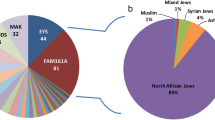Abstract
One hundred forty-eight members of 53 kindreds with familial adenomatous polyposis (FAP) were examined for congenital hypertrophy of the retinal pigment epithelium (CHRPE) and extracolonic manifestations (ECM) to assess the value of CHRPE as a predictive marker for FAP. Based on eye examination results, the families were divided into 2 groups. In a first group of 34 families, all 61 members diagnosed as having polyps and 13 of the 33 patients at risk had 4 or more lesions distributed in both eyes. By contrast, in a second group of 18 families, all 32 polyposis patients and all 18 members at risk had less than 4 lesions. Extracolonic manifestations were present in 26 of 34 families in the first group and in 11 of 18 families in the second group. Data on one family with ambiguous ancestry were reviewed separately. The existence of 4 or more CHRPE lesions distributed in both eyes seems to be a congenital marker for FAP, present in 65.4 percent of families. When present in a family: 1) it is found in all diagnosed patients in that family, 2) can therefore be considered predictive for the development of polyps in other family members who carry the trait, and 3) if confirmed by longer follow-up, may possibly preclude members without the trait from further evaluation and surveillance.
Similar content being viewed by others
References
Diaz-Llopis M, Menezo JL. Congenital hypertrophy of the retinal pigment epithelium and familial polyposis of the colon. Am J Ophthalmol 1987;103:235–6.
Jagelman DG. Extracolonic manifestations of familial polyposis coli. Semin Surg Oncol 1987;3:88–91.
Berk T, Cohen Z, McLeod RS, Parker JA. Congenital hypertrophy of the retinal pigment epithelium as a marker for familial adenomatous polyposis. Dis Colon Rectum 1988;31:253.
Blair NP, Trempe CL. Hypertrophy of the retinal pigment epithelium associated with Gardner's syndrome. Am J Ophthalmol 1980;90:661.
Lewis RA, Crowder WE, Eierman LA, Nussbaum RL, Ferrell RE. The Gardner's syndrome: significance of ocular features. Ophthalmology 1984;91:916–25.
Traboulsi El, Krush AJ, Gardner EJ, et al. Prevalence and importance of pigmented ocular fundus lesions in Gardner's syndrome. N Engl J Med 1987;316:661–7.
Traboulsi El, Maumenee IH, Krush AJ, Giardiello FM, Levin LS, Hamilton SR. Pigmented ocular fundus lesions in the inherited gastrointestinal polyposis syndromes and hereditary nonpolyposis colorectal cancer. Ophthalmology 1988;95:964–9.
Lyons LA, Lewis RA, Strong LC, Zuckerbrod S, Ferrell RE. A genetic study of Gardner syndrome and congenital hypertrophy of the retinal pigment epithelium. Am J Hum Genet 1988;42:290–6.
Romania A, Zakov ZN, McGannon E, Schroeder T, Heyen F, Jagelman DG. Congenital hypertrophy of the retinal pigment epithelium in familial adenomatous polyposis. Ophthalmology 1989;96:879–84.
Offerhaus GJ, Levin S, Giardello FM, et al. Occult radiopaque jaw lesions in familial adenomatous polyposis coli and hereditary nonpolyposis colorectal cancer. Gastroenterology 1987;93:490–7.
Woods R, Sarre RG, Ctercteko GC, et al. Occult radiologic changes in the skull and jaw in familial adenomatous polyposis coli. Dis Colon Rectum 1989;32:304–6.
Jarvis L, Bathurst N, Mohan D, Beckly D. Turcot's syndrome: a review. Dis Colon Rectum 1988;31:907–14.
Jones IT, Jagelman DG, Fazio VW, Lavery IC, Weakley FL, McGannon E. Desmoid tumors in familial polyposis coli. Ann Surg 1986;204:94–7.
Muto T, Agawa S, Ooya M, Morioka Y. Mucin abnormality in colonic mucosa in patients with familial polyposis coli. Semin Surg Oncol 1987;3:179–82.
Lipkin M. Colonic cell proliferation in familial polyposis. Semin Surg Oncol 1987;3:165–70.
Rothberg PG. The role of the oncogen c-myc in sporadic large bowel cancer and familial polyposis coli. Semin Surg Oncol 1987;3:152–8.
Kopelovitch L. Tissue culture assays in familial polyposis coli: observations and considerations. Semin Surg Oncol 1987;3:159–64.
Bodmer WF, Bailey CJ, Bodmer J, et al. Localization of the gene for familial adenomatous polyposis on chromosome 5. Nature 1987;328:614–6.
Leppert M, Dobbs M, Scambler P, et al. The gene for familial polyposis coli maps to the long arm of chromosome 5. Science 1987;238:1411–3.
Meera-Khan P, Tops CM, van den Broek M, et al. Close linkage of a highly polymorphic marker (D5S37) to familial adenomatous polyposis (FAP) and confirmation of FAP localization on chromosome 5q21–q22. Hum Genet 1988;79:183–5.
Rustin RB, Jagelman DS, McGannon E, Fazio VW, Lavery IC, Weakley FL. Spontaneous mutation in familial adenomatous polyposis. Dis Colon Rectum 1990;33:52–5.
Author information
Authors and Affiliations
Additional information
Read at the meeting of The American Society of Colon and Rectal Surgeons, Toronto, Canada, June 11 to 16, 1989.
About this article
Cite this article
Heyen, F., Jagelman, D.G., Romania, A. et al. Predictive value of congenital hypertrophy of the retinal pigment epithelium as a clinical marker for familial adenomatous polyposis. Dis Colon Rectum 33, 1003–1008 (1990). https://doi.org/10.1007/BF02139213
Issue Date:
DOI: https://doi.org/10.1007/BF02139213




